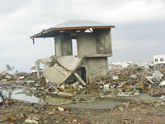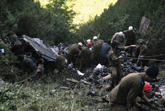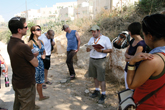×


We have detected your country as:
Please click here to go to the USA website or select another country from the dropdown list.

{image_1}
In February, disaster struck Chile, when an 8.8 Richter Scale earthquake hit the country. In June, an Israeli team of six professionals traveled to Santiago to analyze the aftermath of the disaster and hold a five-day workshop to train more than 300 emergency response personnel from Chile and Paraguay in how to deal with mass casualty events.
Continue Reading »
{image_1}
At a time when the south of Israel has again come under renewed rocket attacks, some 200 Sderot teenagers enjoyed a summer camp experience in August thanks to the Canadian Friends of the Hebrew University of Jerusalem and the Committee for a Secure Sderot. The two organizations created “Lend a Hand to Heal,” a program in which the teenagers enjoy a stimulating, week-long program on the Hebrew University campus. They were introduced to educational and scientific programs as well as sports activities and tours of Jerusalem and its surroundings.
Continue Reading »
{image_1}
A path toward peace may be blowing in the wind, if a new wind energy project between a Palestinian and an Israeli company succeeds. The two companies, Israel Wind Power based in Ramat Gan, near Tel Aviv, and Brothers Engineering Group from Bethlehem in the West Bank [Judea and Samaria], have just announced their intention to cooperate in the building and selling of wind turbines in the West Bank region and beyond. Most significant, they are undeterred by the latest tensions between Israel, the Palestinian Authority, and world powers in the wake of the recent Turkish-led flotilla incident that occurred near Gaza.
Continue Reading »
{image_1}
A natural “bioremediation” technique developed by Israeli biologists may hold the key to the final, difficult steps of the billion dollar oil spill cleanup in the wake of the BP disaster in the Gulf of Mexico. Professors Eugene Rosenberg and Eliora Ron from Tel Aviv University (TAU) use naturally occurring oil-munching bacteria, grown at the TAU lab, to clean hard-to-reach oil pockets that are produced when oil mixes with sand and organic matter on beaches and forms a thin layer on precious waterways.
Continue Reading »
IDF Helicopter Accident in Romania:
{image_1}
“This is a difficult day for all of Israel. We are choked up… hearing about how the heroes [six Israelis and one Romanian]fell from on high, and how the vessels of war fell to the earth.”
— Prime Minister Benjamin Netanyahu
“This year, Israeli and Romanian pilots [are] training together and make the supreme sacrifice together. This has resulted in a closer relationship between us, proving that we support each other in joy but especially in sorrow.”
— Romanian Air Force Deputy Commander Alexander Glushka
Continue Reading »
The Iranians will carry out “the most horrendous suicide bombing in human history…[attacking] Israel, European capitals, and [the] Gulf region at the same time.”
—Former member of Iran’s elite Revolutionary Guard who defected to the US
Continue Reading »
{image_1}
“I think it's possible to achieve it, yes. Will we achieve it with the entire Middle East? That, I cannot say. Can we achieve it with the Palestinians? I say absolutely.”
— Prime Minister Benjamin Netanyahu
Continue Reading »
 |
 |
 |
 |
| David Nekrutman (front left) | David Nekrutman | Cheryl Hauer | The Center for Jewsih-Christian Understanding and Cooperation in Efrat, Gush Etzion |
David Nekrutman is Executive Director of The Center for Jewish–Christian Understanding and Cooperation, established by Rabbi Shlomo Riskin to further interfaith communication. Cheryl Hauer is International Development Director of Bridges for Peace with significant experience in Jewish–Christian relations. Here they comment on the growing relationship between two unlikely groups: Orthodox Jews and evangelical Christians
Continue Reading »
{image_1}
The university has long been revered as a nucleus for the free exchange of ideas, no matter how diverse those ideas might be.
Continue Reading »
Aryeh Schrieber has lived in Kibbutz Nirim in the northern Negev since 1950. Now, aged 77, he has seen this part of the Negev Desert change from being one of the most arid regions in Israel to becoming a rich green, agricultural landscape. “When I came to live here sixty years ago, there was nothing growing. Today…there is almost a thousand acres of irrigated land producing all kinds of citrus fruits, potatoes, carrots, nuts as well as herds of dairy cows,” explains Schrieber with a twinkle in his eye. “Because of the many hours of sunshine, we are able to export all kinds of produce to Europe and Russia, particularly potatoes, because in winter in Europe and Russia, there is a local shortage of such vegetables. Not only that, our produce is of the highest quality.”
Continue Reading »All logos and trademarks in this site are property of their respective owner. All other materials are property of Bridges for Peace. Copyright © 2025.
Website Site Design by J-Town Internet Services Ltd. - Based in Jerusalem and Serving the World.